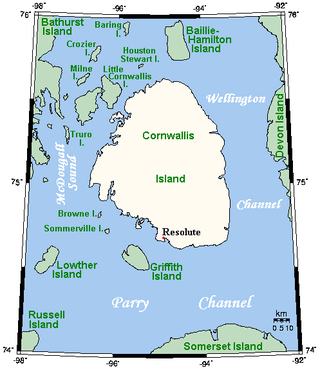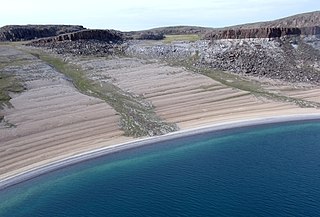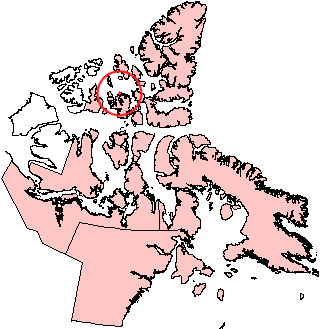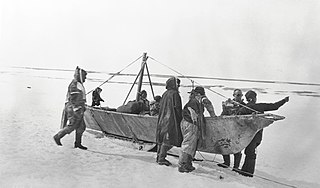
The North Warning System is a joint United States and Canadian early-warning radar system for the atmospheric air defense of North America. It provides surveillance of airspace from potential incursions or attacks from across North America's polar region. It replaced the Distant Early Warning Line system in the late 1980s.

Cornwallis Island is one of the Queen Elizabeth Islands, part of the Arctic Archipelago, in the Qikiqtaaluk Region of Nunavut in the Canadian Arctic. It lies to the west of Devon Island, the largest uninhabited island in the world, and at its greatest length is about 113 km (70 mi). At 6,995 km2 (2,701 sq mi) in size, it is the 96th largest island in the world, and Canada's 21st largest island. Cornwallis Island is separated by the Wellington Channel from Devon Island, and by the Parry Channel from Somerset Island to the south. Northwest of Cornwallis Island lies Little Cornwallis Island, the biggest of a group of small islands at the north end of McDougall Sound, which separates Cornwallis Island from nearby Bathurst Island.

Bathurst Island is one of the Queen Elizabeth Islands in Nunavut, Canada. It is a member of the Arctic Archipelago. An uninhabited island, the area is estimated at 16,042 km2 (6,194 sq mi), 185 to 188 km long and from 101 km (63 mi) to 116 km (72 mi) to 149.5 km (92.9 mi) wide, making it Canada's 13th largest island. It is located between Devon Island and Cornwallis Island in the east, and Melville Island in the west. Four small islands of Cameron, Vanier, Massey and Alexander lie in its northwest.

Alexander Island is one of the Queen Elizabeth Islands of the Canadian arctic islands located in Nunavut, Canada. It lies south of Massey Island and Île Marc, and north of Bathurst Island. Located at 75°52'N 102°37'W it has an area of 484 km2 (187 sq mi), 42.8 kilometres (26.6 mi) long and 19 kilometres (12 mi) wide. Alexander Island is uninhabited.

Loks Land is an uninhabited island in the Arctic Archipelago in Nunavut, Canada. It is located off the eastern tip of Baffin Island's Blunt Peninsula, close to the mouth of Frobisher Bay. It has an area of 419 km2 (162 sq mi) and a coastline of 206 km. The local Inuktitut name for the island is Takuligjuaq.

The Coppermine River is a river in the North Slave and Kitikmeot regions of the Northwest Territories and Nunavut in Canada. It is 845 kilometres (525 mi) long. It rises in Lac de Gras, a small lake near Great Slave Lake, and flows generally north to Coronation Gulf, an arm of the Arctic Ocean. The river freezes in winter but may still flow under the ice.

Bathurst Inlet, officially Kiluhiqtuq, is a deep inlet located along the northern coast of the Canadian mainland, at the east end of Coronation Gulf, into which the Burnside and Western rivers empty. The name, or its native equivalent Kingoak, is also used to identify the community of Bathurst Inlet located on the shore. Melville Sound opens into the eastern side of the inlet at Cape Croker, west of the Hurd Islands.

Tuktut Nogait National Park is a national park located in the Northwest Territories of Canada that was established in 1998. Meaning "young caribou" in Inuvialuktun, the park is home to the calving grounds of the Bluenose-West caribou herd.

Kugluktuk, known as Coppermine until 1 January 1996, is a hamlet at the mouth of the Coppermine River in the Kitikmeot Region of Nunavut, Canada, on Coronation Gulf, southwest of Victoria Island. It is Nunavut's westernmost community, near the border with the Northwest Territories.

Coronation Gulf lies between Victoria Island and mainland Nunavut in Canada. To the northwest it connects with Dolphin and Union Strait and thence the Beaufort Sea and Arctic Ocean; to the northeast it connects with Dease Strait and thence Queen Maud Gulf.

Helena Island is one of the uninhabited members of the Queen Elizabeth Islands of the Canadian Arctic islands in the Qikiqtaaluk Region of Nunavut, Canada. It is along the northern coast of Bathurst Island, separated by Sir William Parker Strait. Seymour Island is located off its west coast. Located at 76°39'N 101°04'W, Helena Island is 327 km2 (126 sq mi) in area and measures 41 by 12.8 km.

The Thelon Wildlife Sanctuary, at 52,000 square kilometres (20,077 sq mi), over twice the area of Belgium, is the largest wildlife refuge in Canada. It is located in northern Canada's Arctic region, north of the tree line, straddling the Northwest Territories and Nunavut, halfway between Baker Lake and Yellowknife, and bordered on the north between the Baillie River on the west and the Consul River at the east by the Back River. It is the namesake of the Thelon River, whose river valley is resplendent with boreal forest biological diversity, hence its identification as a "Biological Site of Universal Importance" by the International Biological Program (IBP) in the 1960s.
Brevoort Island is a small, uninhabited island located in the Davis Strait off the eastern coast of Baffin Island in the Qikiqtaaluk Region of northern Canada's territory of Nunavut. The island is a member of the Arctic Archipelago and lies north of Cape Murchison, opposite the Cumberland Peninsula.

Hornaday River is a waterway located above the Arctic Circle on the mainland of Northern Canada.
The Croker River is a waterway above the Arctic Circle on the mainland of Northern Canada in the western Kitikmeot Region, Nunavut. It is the largest river between Darnley Bay and Coronation Gulf that flows into Amundsen Gulf. The Croker averages 55 m (180 ft) in width.
Putulik, formerly Hat Island, is a small uninhabited island located in the Kitikmeot of Nunavut, Canada. The island is situated in Victoria Strait approximately 110 km (68 mi) southeast of Victoria Island and 80 km (50 mi) southwest of King William Island. The Requisite Channel separates the island from Amundsen Island, the larger of the Nordenskiöld Islands.

Bernard Harbour is a bay on the mainland of Nunavut, Canada. It is situated on Dolphin and Union Strait, southwest of Sutton Island.

Cape Parry is a headland in Canada's Northwest Territories. Located at the northern tip of the Parry Peninsula, it projects into Amundsen Gulf. The nearest settlement is Paulatuk, 100 km (62 mi) to the south, and Fiji Island is located 9 km (5.6 mi) to the west. Cape Parry was formerly accessible through Cape Parry Airport that was located at the Distant Early Warning Line. The airport was listed as abandoned after the closure of the DEW line site.

CFS Resolution Island (BAF-5) is a short-range radar site. It is located 593 miles (954 km) north-northwest of CFB Goose Bay, Labrador on Resolution Island, Nunavut. It is part of the North Warning System. During the Cold War, it was operated as part of the Pinetree Line network controlled by NORAD.

















